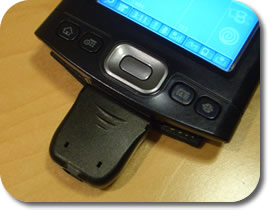New Microphone Module & Audio Activities
 While all Pocket PCs have built-in microphones, most Palm handhelds do not. Handhelds like the Palm TX have had no way of recording audio. Now these handhelds can make and store recordings with the Multiconnector Microphone Module from Tech Center Labs. This $15 microphone attachment hooks to the bottom of a TX handheld. Tech Center Labs is not a large company, but has great customer service. In fact, it seems to be a true mom and pop operation from a married couple's home in Arizona.
While all Pocket PCs have built-in microphones, most Palm handhelds do not. Handhelds like the Palm TX have had no way of recording audio. Now these handhelds can make and store recordings with the Multiconnector Microphone Module from Tech Center Labs. This $15 microphone attachment hooks to the bottom of a TX handheld. Tech Center Labs is not a large company, but has great customer service. In fact, it seems to be a true mom and pop operation from a married couple's home in Arizona.
I received my module a couple of days ago. The module did not come with any documentation, but it doesn't really need any. I simply attached the module to the bottom of my handheld. I loaded the freeware SoundRec and no configuration or drivers were necessary. Though, I did need to soft reset my TX before everything began working properly.
Why do you want a handheld to have a microphone? Well, to record voice, for one thing. Those recordings (usually WAV files) can be imported into iTunes, GarageBand, Audacity, and other audio programs to be turned into a podcast. SoundRec will get the job of recording done. But, if you want more features like the ability to beam sound files, string recordings together, and add notes, there's the $25 Personal Audio Recorder Pro software. Another use for a microphone is to use speech recognition software and internet telephones. Heck, if you have two Wi-Fi enabled Palm handhelds, you can turn them into walkie-talkies with the newly released software WifiTalkie.
Want to hear how the recording sounds? Click here to listen to a recording (6 MB) I made using my new Multiconnector Microphone Module and the SoundRec application. It's me reading this blog post at 22 kHz quality. I saved the audio to an SD card and used a card reader to get the WAV file onto my desktop computer to place on the web.
On the subject of voice recording, one really cool student activity is audio flash cards. This works by students recording a clue. For instance, a student might record, "Patriot hero who was captured and executed by the British." Then the student renames the sound file "Nathan Hale." Students can make several different recordings and use them as flash cards. So, a student looks at the sound file name "Nathan Hale" and tries to think what clue is associated with that name. When the student thinks he knows, he plays the sound file to check his answer. The audio can really help students remember whatever they've associated with the title of the sound file. In fact, it's really fun to have various classmates record the clues using memorable or silly voices.
What ideas do you have about audio recording in the classroom? Please share by leaving a comment!
